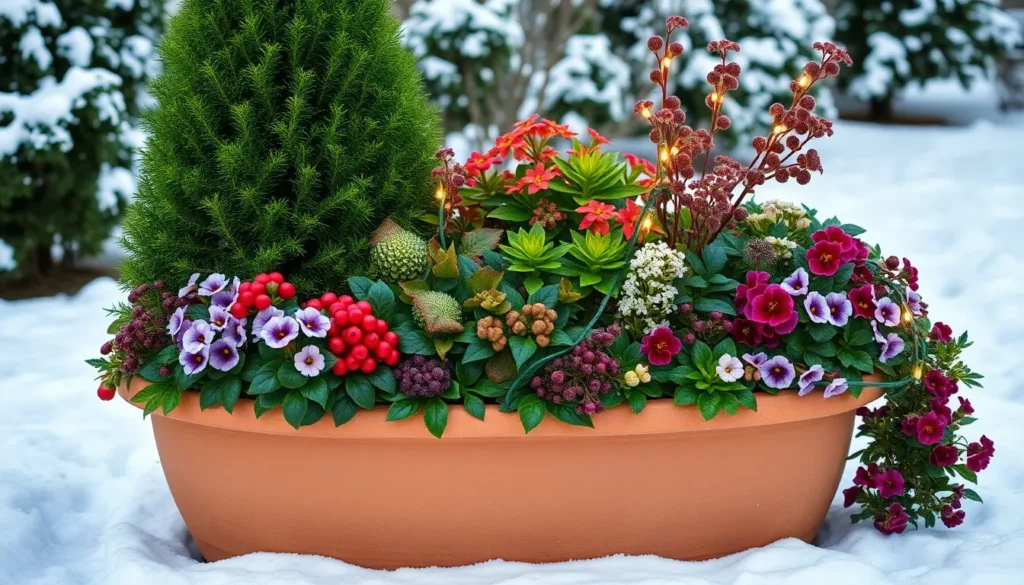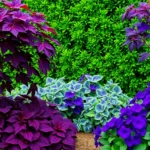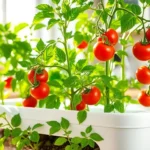Winter doesn’t have to mean barren outdoor spaces and empty planters collecting snow. We’ve discovered that cold-weather gardening opens up a industry of creative possibilities that’ll transform your winter industry into something truly spectacular.
Bold evergreens, vibrant winter berries, and structural elements can create stunning displays that thrive in freezing temperatures. We’re talking about planters that don’t just survive winter – they absolutely shine during the coldest months when most gardens look dormant and lifeless.
Whether you’re working with large statement containers or small windowbox planters, we’ll show you how to design winter arrangements that’ll have your neighbors wondering how you managed to keep such gorgeous displays thriving all season long. From hardy conifers to colorful winter vegetables, these outdoor winter planter ideas will revolutionize how you think about cold-season gardening.
Choose Cold-Hardy Plants That Thrive in Winter Weather
Selecting the right plants forms the foundation of successful winter container gardening. We’ll explore proven options that withstand freezing temperatures while maintaining visual appeal throughout the coldest months.
Evergreen Shrubs and Conifers
Boxwood varieties create stunning structured elements in winter planters, maintaining their glossy green foliage even in temperatures down to -20°F. Common boxwood, Korean boxwood, and wintergreen boxwood offer different sizes and textures for layered arrangements.
Dwarf conifers provide vertical interest and rich colors that intensify during winter months. Blue spruce cultivars like ‘Fat Albert’ and ‘Hoopsii’ develop deeper blue tones in cold weather, while dwarf Alberta spruce maintains perfect pyramid shapes in containers.
Winter holly species deliver both evergreen structure and bright berries that persist through harsh weather. Inkberry holly tolerates temperatures to -30°F and produces clusters of dark berries, while winterberry holly offers vibrant red berries on bare branches.
Juniper varieties thrive in winter containers with minimal care requirements. Creeping juniper spreads gracefully over planter edges, while upright junipers like ‘Skyrocket’ create dramatic vertical elements that withstand wind and snow.
Winter-Blooming Flowers
Pansies bloom continuously in temperatures as low as 15°F, offering faces in purple, yellow, orange, and white combinations. Cool weather actually enhances their flower production, making them ideal for winter color displays.
Winter flowering kale produces rosettes in deep purple, pink, and cream that become more vibrant as temperatures drop. Ornamental cabbage varieties like ‘Nagoya’ and ‘Osaka’ maintain their colorful centers throughout winter months.
Cyclamen species bloom from fall through early spring in USDA zones 5-9. Hardy cyclamen produces delicate pink or white flowers above marbled leaves that persist through snow and ice.
Primrose varieties begin blooming in late winter, signaling spring’s approach with bright yellow, pink, and purple flowers. English primrose and drumstick primrose tolerate light frosts while continuing to produce new blooms.
Ornamental Grasses and Sedums
Fountain grass maintains its graceful arching form throughout winter, with seed heads that catch snow and create textural interest. Purple fountain grass adds burgundy tones that complement evergreen backgrounds.
Sedum varieties store water in thick leaves that resist freezing damage. Autumn Joy sedum develops russet flower heads that persist through winter, while Dragon’s Blood sedum creates low carpets of red foliage.
Festuca grasses form neat blue-green clumps that remain attractive in winter containers. Blue fescue and sheep fescue varieties require minimal water and thrive in cold conditions down to -40°F.
Heuchera cultivars provide colorful foliage that intensifies during cold weather. Purple Palace, Fire Chief, and Caramel varieties develop deeper colors as temperatures drop, creating stunning contrasts with evergreen companions.
Select Weather-Resistant Containers for Harsh Conditions
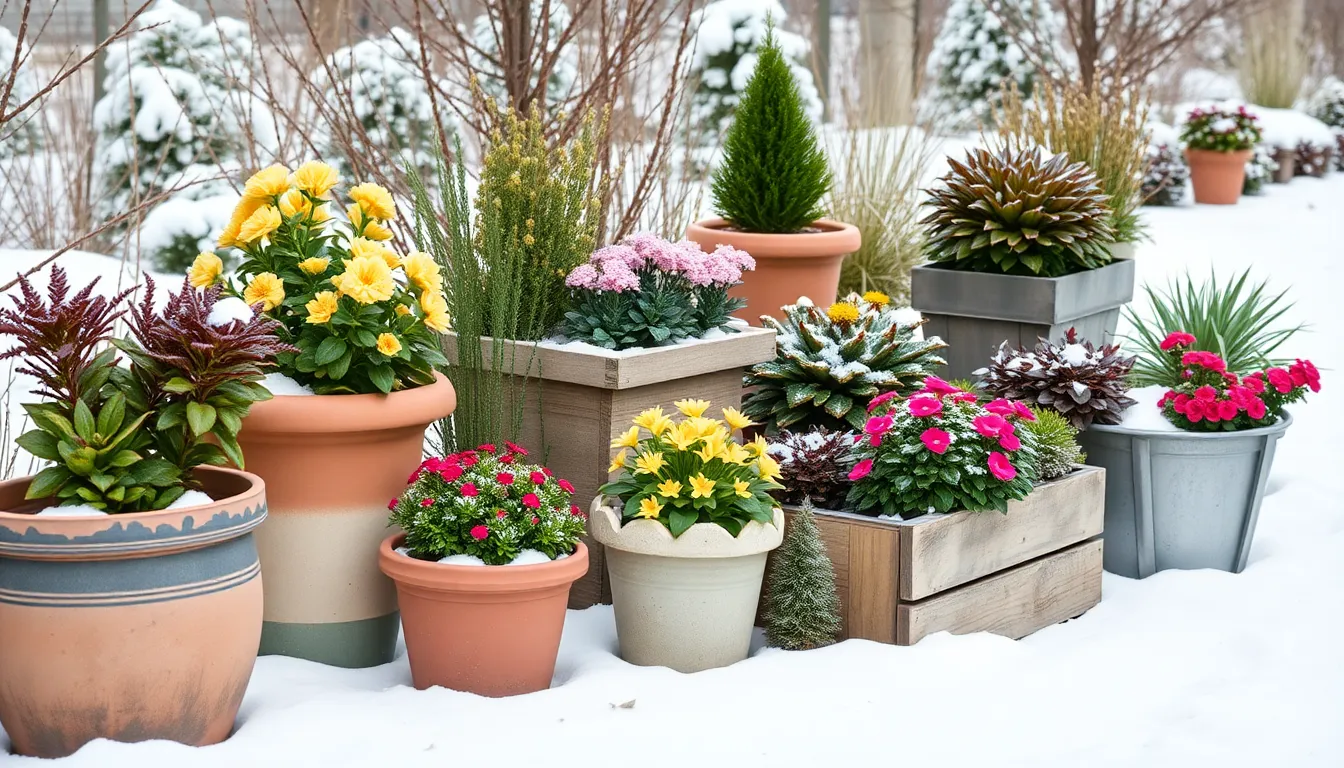
Choosing the right container is crucial for winter planter success, as harsh weather conditions can quickly damage inferior materials. We’ll focus on selecting containers that protect your plants while maintaining their beauty throughout the coldest months.
Frost-Proof Materials and Options
Terra cotta containers offer excellent durability when unglazed, allowing moisture to escape and preventing freeze damage that cracks sealed surfaces. Ceramic planters work exceptionally well for winter displays, though we recommend selecting unglazed varieties to avoid water absorption issues during freeze-thaw cycles.
Wood containers provide natural insulation for plant roots while adding rustic charm to winter arrangements. Metal planters resist cracking and offer contemporary styling, though they conduct cold temperatures more readily than other materials.
Insulated containers become essential when using plastic or lightweight materials that don’t naturally withstand temperature fluctuations. We suggest wrapping these containers with straw or foam insulation to maintain consistent soil temperatures throughout winter months.
Thermal mass additions like stone or brick bases help absorb daytime heat and release it gradually during cold nights. These materials create microclimates around your plants that can make the difference between thriving and surviving harsh conditions.
Proper Drainage Requirements
Small rocks or broken pottery should form the bottom layer of every winter container to ensure water drains efficiently and prevents root rot. This drainage layer becomes even more critical during winter when wet soil freezes and damages plant roots.
Drainage holes must remain unobstructed throughout winter, as blocked holes cause water to accumulate and freeze. We recommend checking drainage regularly and clearing any debris that might prevent proper water flow.
Elevated positioning helps containers drain more effectively by preventing them from sitting in puddles of melted snow or ice. Placing containers on bricks or pot feet ensures continuous drainage even during winter storms.
Size Considerations for Root Protection
Container depth should measure at least 12 to 14 inches to provide adequate root space and insulation from freezing temperatures. Deeper containers offer better root protection and allow for more elaborate plant combinations in your winter displays.
Width considerations matter equally, as wider containers provide more soil volume to insulate roots and accommodate multiple plants. We find that containers measuring 18 inches or more in diameter create the most impressive winter arrangements.
Root zone protection improves dramatically with larger containers, as increased soil volume doesn’t freeze as quickly as smaller amounts. Generous container sizes also allow us to add mulch layers that further insulate plant roots from temperature extremes.
Create Stunning Evergreen Arrangements for Year-Round Color
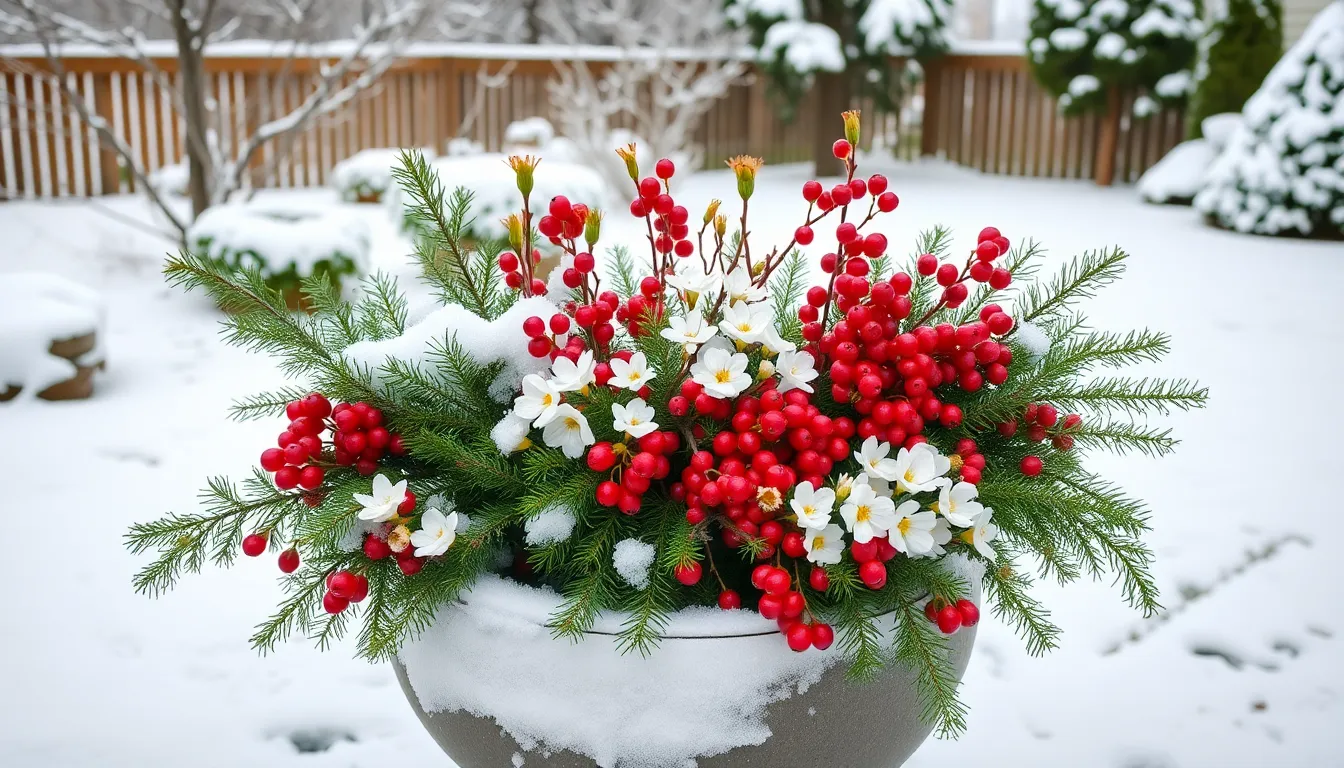
Evergreens form the backbone of successful winter planters, providing structure and color when most plants have gone dormant. We’ll show you how to build arrangements that maintain their beauty throughout the coldest months.
Layering Different Textures and Heights
Combining textures creates visual drama that makes winter planters truly captivating. We recommend mixing fine, feathery evergreen needles from spruce or silver fir with bold, shiny winter berry foliage to achieve striking contrasts that capture winter’s natural beauty.
Varying heights adds depth and professional appeal to your arrangements. We suggest using tall evergreens like juniper as anchor plants in the back, then layering medium-height branches in the middle, and finishing with low-growing flowers or trailing greens at the front edge.
Building your planter from back to front ensures each element gets proper visibility. We place the tallest evergreen branches first, creating a backdrop that supports and frames the entire composition while providing the sturdy foundation your arrangement needs.
Incorporating Berries and Branches
Berries bring vibrant pops of color that make winter planters come alive against snowy backgrounds. We love using winterberry holly or cotoneaster because they provide brilliant red and orange hues while serving as valuable food sources for wintering birds in your garden.
Branches add structural interest and complement berry displays perfectly. We incorporate cardinal dogwood spikes or Fraser fir branches to create architectural elements that give arrangements professional polish and winter-appropriate texture.
Fresh or dried branches work equally well depending on your design goals. We often mix both types, using fresh evergreen branches for their rich color and dried decorative branches for their unique shapes and long-lasting appeal.
Color Combinations That Pop Against Snow
Contrasting colors create the most striking winter displays when snow covers your outdoor spaces. We pair deep evergreen foliage with brightly colored berries or winter-blooming flowers like pansies and cyclamen to achieve maximum visual impact against white backgrounds.
Elegant white combinations offer sophisticated winter beauty that complements snowy landscapes. We use white pine or Scotch pine with white winter flowers to create monochromatic arrangements that blend seamlessly with winter’s natural palette while maintaining distinct visual interest.
Bold color schemes work exceptionally well in winter planters because they stand out dramatically. We combine silver fir with bright red winterberries and purple pansies to create arrangements that remain visible and beautiful even during heavy snowfall.
Design Eye-Catching Seasonal Displays with Winter Elements
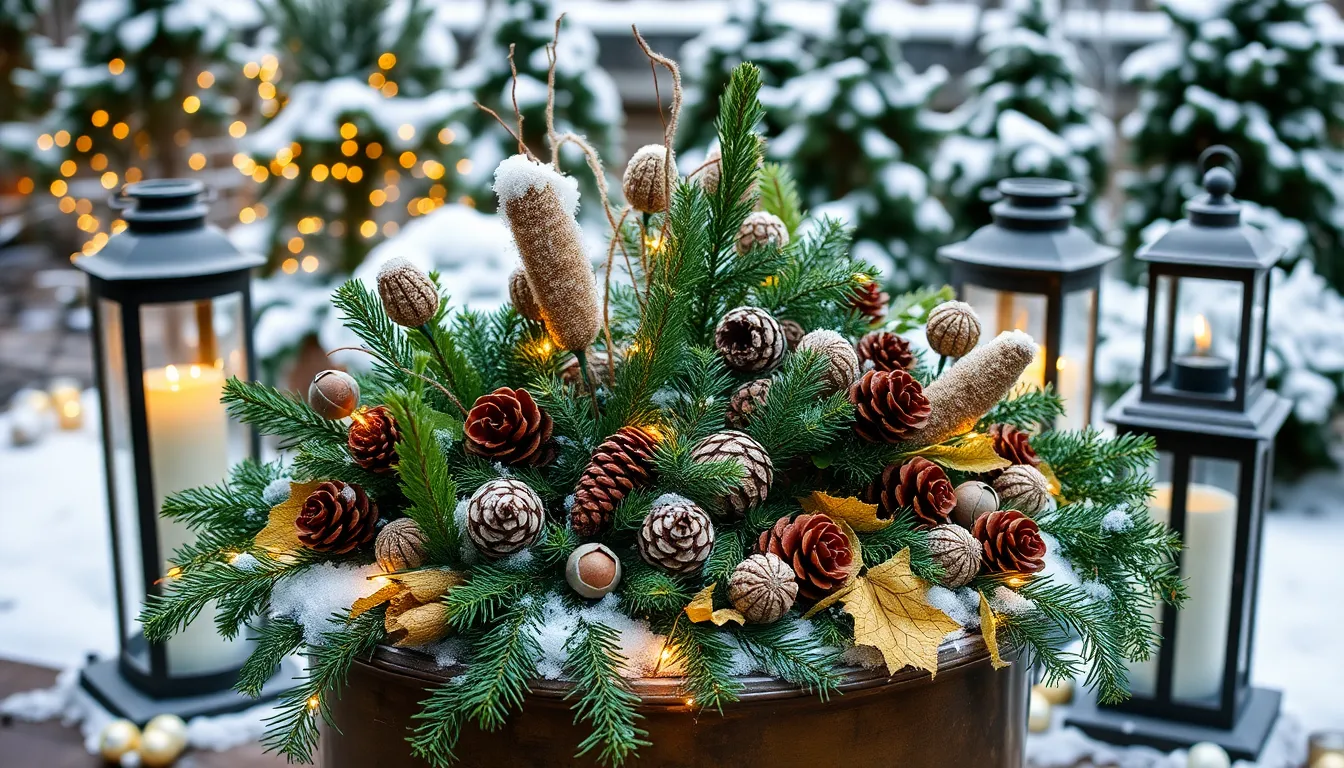
Natural elements transform basic winter containers into captivating seasonal masterpieces. We’ll explore how to layer textures, colors, and lighting for displays that shine throughout the coldest months.
Adding Pinecones and Natural Decorations
Pinecones create instant rustic charm when nestled between evergreen branches in your outdoor planters. We recommend gathering various sizes from spruce, pine, and fir trees to add dimensional interest and organic texture to winter displays.
Architectural branches enhance visual drama by introducing height variations and structural elements. Birch branches, curly willow stems, and bare dogwood twigs provide striking silhouettes against snow covered backgrounds.
Natural bark pieces add earthy foundation layers that complement both traditional and modern container styles. We suggest using cedar strips, oak chunks, or pine bark mulch to create textural contrast with smooth evergreen needles.
Dried seed pods bring unexpected sculptural elements to winter arrangements through their unique shapes and weathered surfaces. Lotus pods, milkweed cases, and ornamental grass plumes maintain their form throughout freezing temperatures.
Including Festive Lighting Options
Twinkle lights wrapped around evergreen branches create magical evening displays that extend your outdoor enjoyment beyond daylight hours. We recommend using LED string lights rated for outdoor winter conditions to ensure safe operation in freezing temperatures.
Solar powered stake lights eliminate electrical concerns while providing consistent illumination throughout long winter nights. Battery operated options with timers offer flexible placement without weather related safety issues.
Lantern style candle holders add warm ambient lighting that complements natural winter elements beautifully. We suggest using flameless LED candles in glass or metal lanterns to avoid fire hazards during windy conditions.
Pathway lighting creates cohesive outdoor themes by connecting your container displays with surrounding industry features. Small spotlights directed upward highlight textural details in your winter arrangements after dark.
Incorporating Seasonal Colors and Themes
Winter color palettes featuring greens, reds, and golds create timeless seasonal appeal that photographs beautifully against snow covered settings. We recommend using these traditional combinations as your foundation before adding accent colors.
Christmas themed decorations transform planters into festive focal points through carefully placed ornaments, ribbons, and seasonal accessories. Weatherproof baubles, waterproof ribbon, and outdoor garland maintain their appearance throughout winter storms.
Monochromatic schemes using varied textures offer sophisticated alternatives to traditional holiday colors while maintaining visual interest. Silver and white combinations featuring dusty miller, white pansies, and frosted pinecones create elegant winter sophistication.
Bold accent colors like deep purple or bright orange provide unexpected pops that energize neutral winter landscapes. We suggest using winter flowering kale, colorful dogwood stems, or painted decorative elements to introduce these vibrant touches strategically.
Protect Your Plants from Freezing Temperatures and Wind
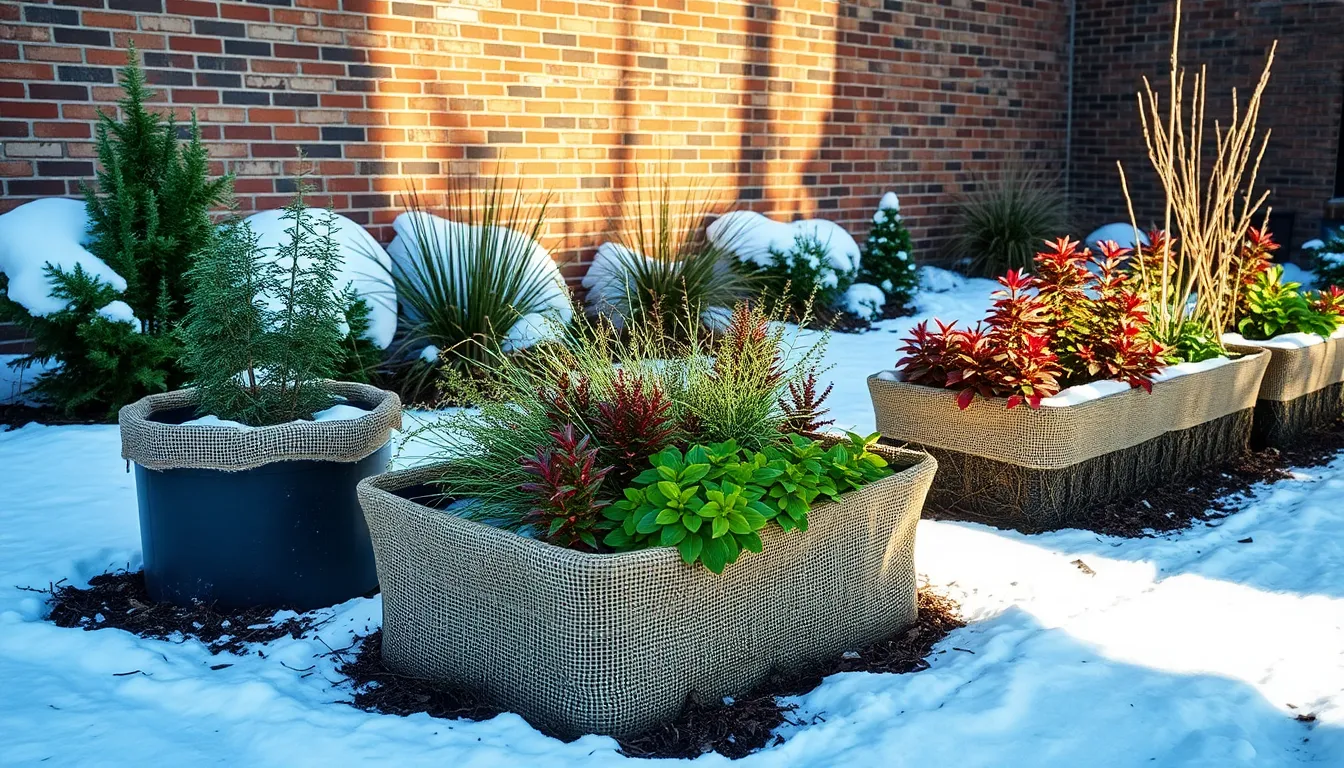
Now that we’ve created our beautiful winter displays, we need to ensure our plants survive harsh winter conditions. Winter protection involves combining effective insulation methods with smart positioning strategies.
Insulation Techniques and Materials
Rigid foam insulation provides excellent thermal protection when cut to fit inside planters. We recommend avoiding the bottom area to maintain proper drainage while still protecting root zones from freezing.
Mulch and pine needles create natural insulation layers around plants. These organic materials help retain soil moisture while providing essential temperature regulation during cold snaps.
Chicken wire and mulch method offers superior protection through a simple yet effective technique. We surround pots with chicken wire barriers filled with hay or mulch to reduce dramatic temperature fluctuations that can stress plants.
Burlap and bubble wrap combinations shield planters from both wind and cold exposure. Wrapping containers with these materials creates multiple insulation layers while allowing plants to breathe properly.
Strategic Placement and Positioning
Wall placement maximizes protection by positioning planters against building walls or fences. These structures provide radiant heat and create windbreaks that significantly reduce plant stress during storms.
Grouping techniques involve clustering hardier plants around more sensitive varieties. We create protective barriers by arranging cold tolerant species as shields for delicate plants that need extra care.
DIY cold frame construction uses straw bales and transparent covers to build homemade protection systems. These structures provide better insulation while maintaining essential light exposure for continued plant growth.
Watering Schedule Adjustments
Reduced watering frequency becomes essential during winter months due to decreased plant activity. We water less often because plants require minimal moisture when growth slows and evaporation rates drop significantly.
Moisture monitoring prevents overwatering issues that commonly occur in cold conditions. Regular soil checks help us avoid root rot problems while ensuring plants receive adequate hydration for winter survival.
Maintain Your Winter Planters Throughout the Season
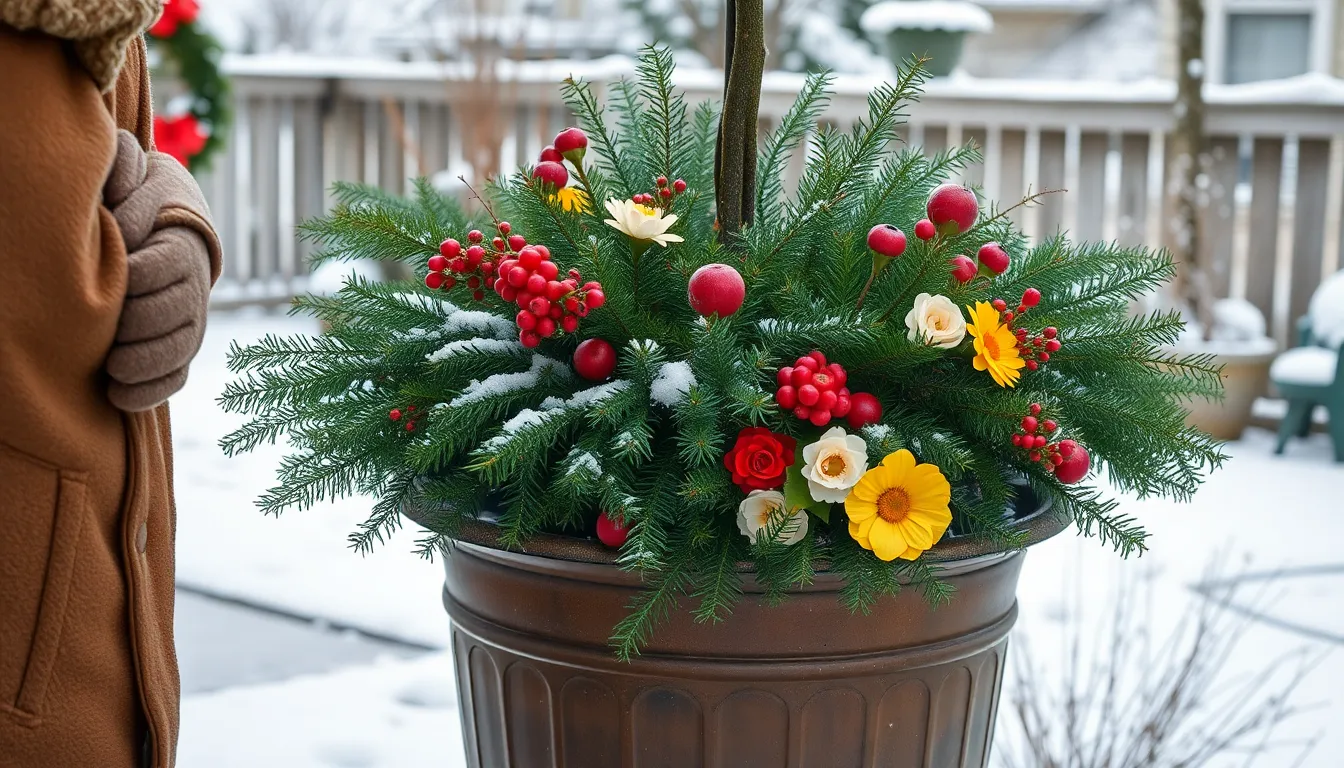
Keeping our winter planters vibrant throughout the cold months requires consistent attention and strategic care. We’ll focus on three essential maintenance practices that ensure our outdoor displays remain stunning from December through March.
Regular Care and Monitoring
Monitor moisture levels weekly to prevent both drought stress and waterlogged conditions in our containers. Evergreens and dried materials generally require minimal watering during winter months, but we should check soil moisture by inserting our finger 2 inches deep into the potting mix.
Check drainage holes monthly to ensure water flows freely and doesn’t freeze, creating ice blockages that can damage roots. We can use a wooden skewer or small stick to clear any debris from drainage openings.
Inspect plant health bi-weekly by examining evergreen needles for browning, berry clusters for shriveling, and structural elements for stability. Winter winds and temperature fluctuations can stress plants more than we might expect.
Adjust watering frequency based on weather patterns, reducing irrigation during snowy periods and increasing slightly during dry, windy spells. We should water early in the day when temperatures are above freezing to prevent ice formation around roots.
Replacing Damaged Elements
Remove damaged foliage immediately when we notice brown or yellowing evergreen branches, as these can attract pests and detract from our display’s overall appearance. Fresh cuts should be made just above healthy growth nodes using clean pruning shears.
Replace wilted flowers like pansies or cyclamen as soon as they show signs of decline, swapping them for fresh blooms or winter-hardy alternatives. We can often find replacement plants at garden centers throughout the winter season.
Refresh berry branches when winterberry holly or cotoneaster clusters become sparse or discolored, sourcing new cuttings from our garden or purchasing fresh stems from floral suppliers.
Stabilize loose elements by securing grapevine spheres, decorative branches, or other structural components that may have shifted due to winter weather. We should check these weekly after storms or high winds.
Preparing for Spring Transitions
Plan container modifications starting in February by selecting plants that can transition smoothly from winter to spring displays. We should consider which elements we want to keep and which we’ll replace with emerging spring bulbs or early perennials.
Choose adaptable containers that we can easily modify by adding new soil layers or removing winter-exact decorations while maintaining the basic planter structure.
Source spring additions by ordering bulbs, seeds, or young plants in late winter so we’re ready to refresh our displays as temperatures warm. We can begin incorporating early spring elements like pussy willow branches or emerging bulb foliage in March.
Maintain soil quality by adding fresh potting mix to containers as winter elements are removed, ensuring our planters have nutrient-rich growing medium for spring plants.
Conclusion
Winter gardening doesn’t have to mean empty containers and barren landscapes. With the right combination of hardy plants weather-resistant containers and thoughtful design we can create stunning outdoor displays that thrive throughout the coldest months.
From evergreen arrangements to colorful winter blooms these planters offer endless possibilities for creative expression. The key lies in choosing frost-tolerant plants proper drainage and strategic placement to protect our displays from harsh weather conditions.
By following these guidelines and maintaining consistent care throughout the season we’ll enjoy beautiful winter gardens that brighten even the gloomiest days. Start planning your winter containers now and discover how rewarding cold-weather gardening can truly be.
Frequently Asked Questions
What plants work best for winter container gardening?
Cold-hardy evergreens like boxwood, dwarf conifers, and juniper varieties form excellent backbones for winter planters. Winter-blooming flowers such as pansies, cyclamen, and flowering kale add vibrant color. Ornamental grasses and sedums provide texture and resilience. Winter holly species contribute both structure and bright berries, creating visually appealing arrangements that thrive in freezing temperatures.
What type of containers are best for winter gardening?
Choose frost-proof materials like unglazed terra cotta, ceramic, wood, or metal containers that resist freeze damage. Containers should be at least 12-14 inches deep and 18 inches wide for proper root protection. Ensure adequate drainage with small rocks or broken pottery, and consider insulated options or adding thermal mass like stone bases for extra plant protection.
How do I create attractive color combinations for winter planters?
Use contrasting colors that pop against snowy backgrounds, such as deep greens with bright reds or golden yellows. Elegant monochromatic schemes in whites and silvers create sophisticated displays. Bold accent colors like purple or orange can energize winter landscapes. Layer different textures and heights using tall evergreens, medium branches, and trailing plants for visual depth.
How should I protect my winter plants from harsh weather?
Use insulation techniques like rigid foam, mulch, or chicken wire barriers filled with hay around containers. Place planters against walls or fences for wind protection and group hardier plants around sensitive varieties. Monitor for ice damage and adjust watering schedules since plants need less water in winter to prevent root rot and freezing damage.
How do I maintain winter planters throughout the season?
Monitor moisture levels regularly and check drainage holes to prevent waterlogging. Inspect plant health weekly, removing damaged foliage and replacing dead plants promptly. Stabilize loose decorative elements and refresh mulch as needed. Reduce watering frequency compared to growing season, allowing soil to dry slightly between waterings to prevent freeze damage.
Can I add decorative elements to winter planters?
Yes, incorporate natural elements like pinecones, architectural branches, and dried seed pods for texture and visual drama. Add festive LED string lights or lantern-style candle holders for magical evening displays. Use seasonal decorations in Christmas themes or sophisticated monochromatic schemes, ensuring all additions are weather-resistant and securely attached to withstand winter conditions.

